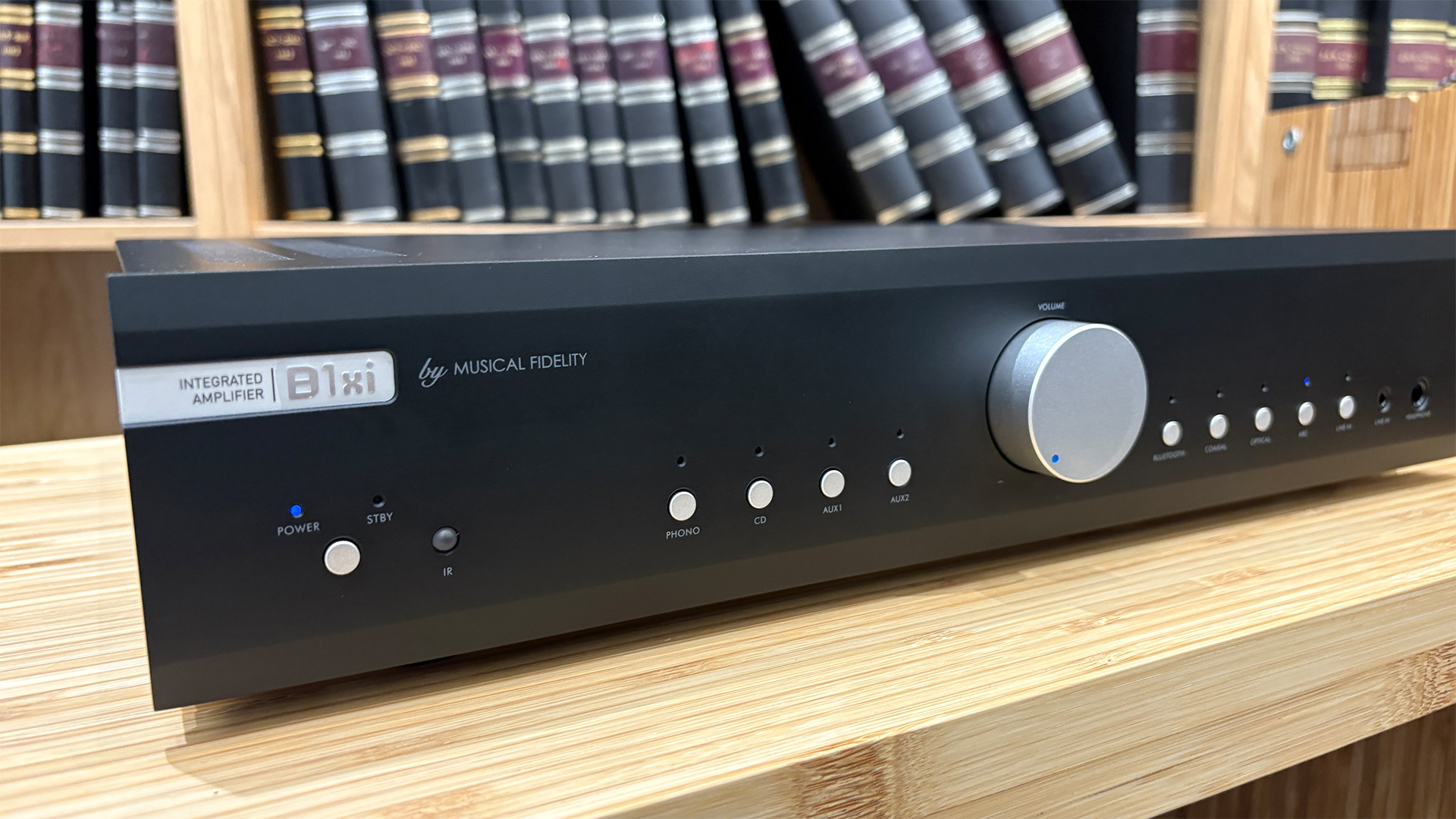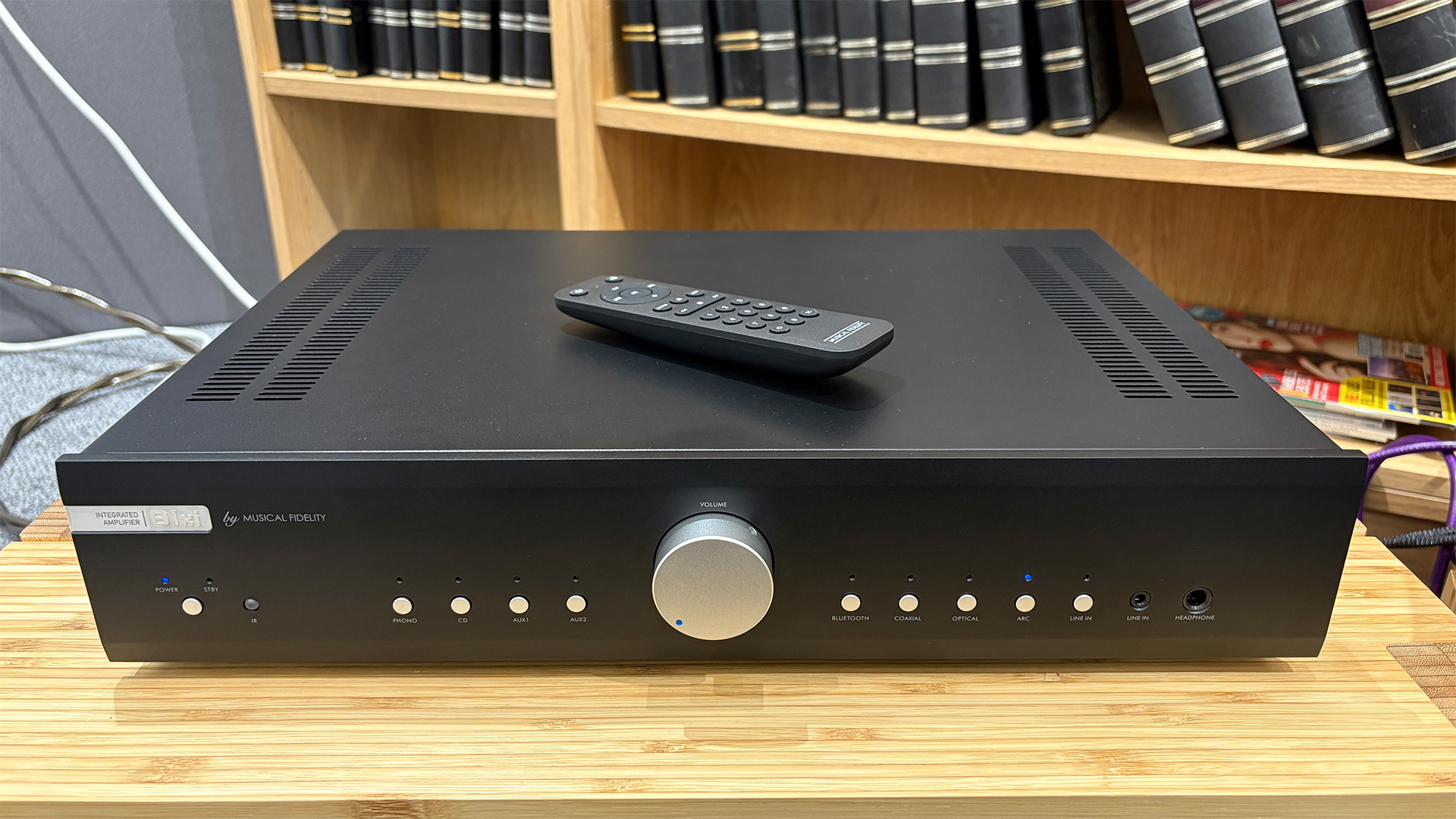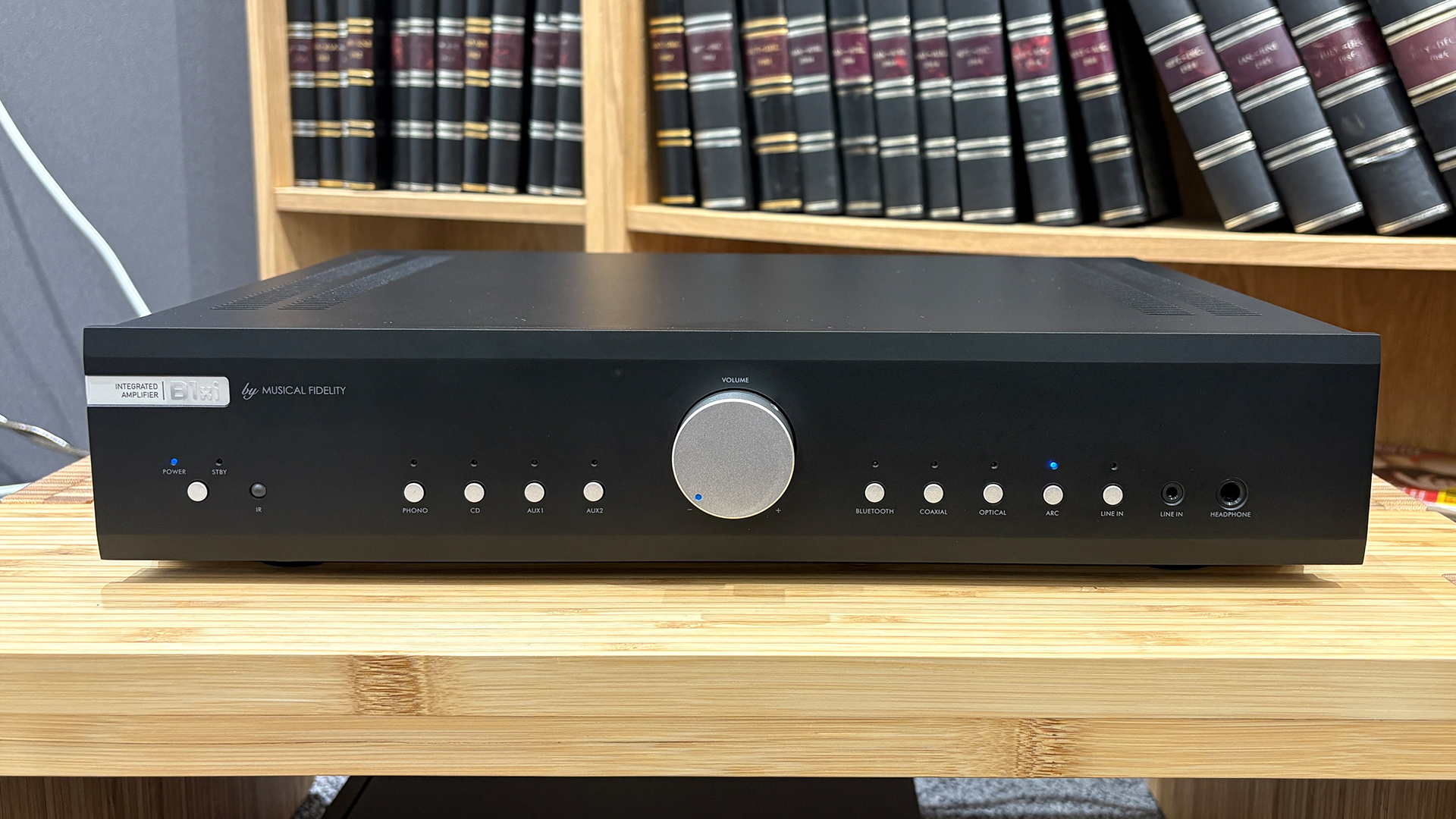What Hi-Fi? Verdict
The B1xi is a punchy, muscular amplifier that performs well in isolation, even if class-leading rivals offer greater clarity, insight and dynamic handling
Pros
- +
Direct, punchy presentation with ample bass
- +
Broad, cinematic soundstage
- +
Solid feature set
- +
Decent phono stage
Cons
- -
Lacks the drama of class-leading rivals
- -
Headphone output could be better
- -
Could be more responsive to the remote control’s actions
Why you can trust What Hi-Fi?
Do you know when we reviewed the original Musical Fidelity B1 integrated amplifier? 1990.
Back then, we lauded it as “the very essence of a good budget amplifier”, and while we weren’t bowled over by the B1’s construction or feature set, the original model gained five stars in the sound department thanks to its powerful dynamics and boldly painted instrumental textures.
Like mullets or skinny jeans (apparently), the B1 is making a comeback in the shape of the newly imagined B1xi integrated stereo amplifier. It’s a spiritual successor inspired by the design principles of Musical Fidelity’s established amplifier but with one eye on modern users’ “diverse listening needs”.
Digging up the past is a dangerous thing, so has Musical Fidelity reinvented a classic, or in the world of hi-fi, are some things best left buried?
Build & design

Musical Fidelity’s reborn stereo amp isn’t a particularly subtle beast to behold, but it is as well-made as it needs to be at this price. The main chassis is constructed entirely of metal, including an extruded aluminium front panel, with many of the control knobs and dials also made using metal rather than plastic.

Type Integrated
Power 60W per channel into 8 ohms
Phono stage? Yes, moving magnet
Inputs Line level x 3, 3.5mm aux, HDMI ARC, Coaxial, Optical
Outputs Preamp
Bluetooth? Yes, 5.1
Headphone output? Yes (6.3mm)
Dimensions (hwd) 90 x 43 x 32.4
Weight 7.2kg
Regardless of whether it’s to your tastes, the B1xi is a sturdy unit that we find reasonably easy to use. The front panel’s array of physical buttons are easy to find and responsive to the touch, while the centrally mounted volume control knob has enough weight and resistance to feel satisfying in the hand. The small LEDs above each of the inputs tell you which one you have selected.
This is a well made amplifier for the money, and while there are few luxuries to be found, we wouldn’t expect many at this level. The provided plastic remote is similarly simple to use, even if, during our testing, the B1xi can be a touch temperamental regarding how responsive it is to the remote’s commands.
The latest hi-fi, home cinema and tech news, reviews, buying advice and deals, direct to your inbox.
Features

Musical Fidelity’s Class A/B amp boasts 60 watts per channel into 8 ohms, which is a generous amount of power at this level, meaning it should be able to drive a wide range of speakers without too much of a problem.
The amplifier’s power supply is based around a toroidal transformer, and is claimed to have large power reserves in pursuit of the "purest sound quality". Musical Fidelity promises a warm, dynamic sound that’s designed to invoke the quality of a valve or tube amp thanks to the use of transistor amps in the fully discrete design.
The B1xi claims to use high-quality components throughout its design, with an internal layout optimised for enhanced performance. The preamplifier section has its own dedicated linear power supply (as does the digital input stage) for reducing interference, while a motor-driven analogue potentiometer controls the volume.
In a nod to those modern users, Musical Fidelity has furnished the B1xi with a wide range of connections.
On the analogue side, the B1xi has a moving magnet phono stage for plugging a turntable in directly. You’ll also find a 3.5mm auxiliary input, three line-level RCA inputs, and a stereo preamp output.
On the digital side, the integrated amp offers HDMI ARC, optical and coaxial inputs. The in-built DAC module supports native playback up to 24-bit/192kHz PCM files, but those with DSD files in their library will be left disappointed by the lack of compatibility.
That HDMI ARC is a big bonus for amplifying audio from your TV, while a USB-C port at the back can be used to power external devices, such as your smartphone.
You also get Bluetooth connectivity for beaming music to the amplifier from a compatible source, and while this isn’t the same as the two-way tech you’ll find on the rival Arcam A5+, we’re still pleased to find any form of Bluetooth at this mid-price level.
Pairing up a phone is easy, and we’re impressed with how stable and secure the connection is when we use an iPhone 15 to send our tunes to the integrated amp via Bluetooth.
Compatibility

We listen to the B1xi in a range of systems, from price-compatible products to more premium hi-fi systems, fully in the knowledge that it is designed to work with more affordable gear.
To hear how well the B1xi performs with more price-compatible fare, we pair it up with a set of the five-star Acoustic Energy AE300 Mk2 speakers (£649 / $1099 / AU$1580) and use the ever-dependable Cyrus CDi CD player (£999) as a source. We find that the Musical Fidelity amp feels comfortable at this level.
We also dig out our old favourites, the KEF LS50 Meta (tested at £1000 / $1499 / AU$2495), discovering that the B1xi is once again happy to play ball with these pricier standmounts, making the KEFs viable partners for the Musical Fidelity amp to work with.
Just for fun, we slot the B1xi into our reference system comprising the Naim Uniti Atom Headphone Edition music streamer (£2299 / $3799) and a pair of five-star Epos ES-7N standmounts (£1890 / $2850), discovering that the amplifier is even able to accommodate our open, revealing system.
This is clearly an amp that has a reasonably wide remit and is able to accommodate budget sources as well as more capable components when really pushed.
Sound

If we had to assign it a broad label, we’d say that the B1xi exhibits a punchy, solid character. Play Pearl Jam’s Dark Matter, for instance, and you’ll be struck by the heft and force of the song’s thumping opening salvo as full-bodied drums are joined by crunchy, full-scale guitar cranks.
The B1xi feels as though it’s in its element as it leans into the music and dishes out ample wallop with fulsome glee. We sense that this is an amp that’s happiest when it’s operating on the front foot, so that bold hip-hop workouts, thumping EDM tracks and riotous rock are particularly well-served by its assertive, sometimes bullish tendencies.
Detail levels are admirable, evidenced by the crisp, well-defined strings on Radiohead’s Burn The Witch. We’re extremely familiar with Thom Yorke’s voice by now (we’ve heard it enough), and we recognise the personality of the iconic frontman’s signature wail as the integrated brings out the raw drama of his increasingly urgent vocals.
The B1xi doesn’t struggle to produce a feeling of scale or power, either, with the scale of the overall presentation impressively ample as Burn The Witch builds to its nerve-shredding climax. It’s a track that starts out small and edgy, but thanks to the amp’s cinematic scope, the music is able to grow into something far more cinematic as the strings build and our anxiety is turned up to eleven.
The B1xi showcases competence when it comes to stereo imaging, too. More cinematic recordings blossom nicely to sound well-realised, with a wider, deeper soundstage than cheaper amps, such as the five-star Rotel A8 (£399 / $449 / AU$649), can muster.
Of course, we wouldn’t be doing our job if we didn’t see how Musical Fidelity’s contender stacked up against its price rivals, meaning it’s time to dig out the recently reviewed and new Award winner, the Arcam A5+ (£749 / $1200 / AU$1595), to see if the B1Xi can beat this impressive benchmark. It is here, crucially, that we remember how high the standard has been set.

Stay with us for a minute, but imagine we’re talking about food. The B1xi is a tasty burger, albeit a burger plucked from the ovens of a reputable fast food chain. The Arcam, however, is the full Gordon Ramsay – the bun is that bit crisper, the lettuce is a little fresher, and the addition of a metaphorical pickle and some golden fries just makes the whole experience feel a touch more gourmet.
Okay, maybe we’re stretching things with the burger analogies, yet it’s clear that the A5+ serves up a more rounded, musical meal. It’s clearer and more detailed, as evidenced by the clean, crisp delivery it brings to Burn The Witch and Massive Attack’s Risingson. It’s got a better sense of rhythm, too – the Arcam is snappy and propulsive, and it makes its rival sound slightly flat-footed and unsure of itself by comparison.
In truth, we wish the B1xi were a more nuanced, expressive performer. Max Richter’s sombre Never Goodbye sounds full-bodied and powerful, yet we don’t get the feeling of the Musical Fidelity amp removing its happy face and donning a more appropriately melancholic mask.
The sometimes unsubtle integrated amp paints music with a similarly broad brush, with a relatively uninspired handling of small scale dynamics reducing the drama of the music by flattening those emotive peaks and troughs.
For better or worse, these observations remain reasonably consistent no matter how we listen, and thanks to the B1xi’s decent range of features, there are numerous ways of doing so.
The built-in phono stage is of an admirable quality, making tracks such as Lukas Graham’s Happy Home and Bach’s Siciliano In G Minor sound full, composed and nicely detailed when played via the Rega Planar 3 RS Edition turntable (£999 / $1795 / AU$2199).
Again, a more engaging sense of dynamic handling wouldn’t go amiss, and if you’re serious about your vinyl, then we would suggest that you consider an outboard phono stage if you have a spinner that’s more high-end than this Rega, but for most users, the phono module in the B1xi will do just fine.
To hear how competent Musical Fidelity’s on-board DAC module is, we connect our trusty Cyrus CDi CD player to the amp’s optical input.
The performance remains consistent without a notable drop-off – Soundgarden’s Down On The Upside is reasonably detailed and has ample solidity as we move from track to track, whereas Hans Zimmer’s brooding The Dark Knight soundtrack benefits from the B1xi’s bold, cinematic delivery.
If that phono stage and DAC module are plus points, we can’t quite say the same when it comes to the amp’s front-mounted 6.3mm headphone port.
We’ve become familiar with the talents of the five-star Beyerdynamic DT 990 Pro X wired over-ears, though our test pair don’t quite sound themselves via the B1xi. It’s not a wholly bad showing, but the Beyerdynamics don’t have the same clarity or musicality as when fed by the five-star Arcam A5+.
Verdict

Judged on its own terms, the Musical Fidelity B1xi is a competent performer, showcasing a bold, assertive sound that’s complemented by a well-stocked feature set.
However, when listened to in the context of rivals in the same price range, with the likes of the superb Arcam A5+ leading the charge, it makes Musical Fidelity’s admirable effort a trickier sell.
Good as the B1xi is, if it were our money, we would be more tempted to spend a little extra and get the A5+ instead.
SCORES
- Sound 4
- Features 5
- Build 4
MORE:
How to build the perfect hi-fi system
Read our review of the Arcam A5+
Also consider the Rega Brio Mk7
Our pick of the best stereo amplifiers you can buy for every budget

Harry McKerrell is a senior staff writer at What Hi-Fi?. During his time at the publication, he has written countless news stories alongside features, advice and reviews of products ranging from floorstanding speakers and music streamers to over-ear headphones, wireless earbuds and portable DACs. He has covered launches from hi-fi and consumer tech brands, and major industry events including IFA, High End Munich and, of course, the Bristol Hi-Fi Show. When not at work he can be found playing hockey, practising the piano or trying to pet strangers' dogs.
- Ketan BharadiaTechnical Editor
You must confirm your public display name before commenting
Please logout and then login again, you will then be prompted to enter your display name.

